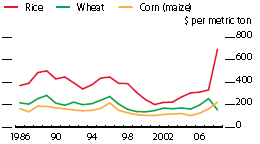It is a surprising fact that the cost of food in the life of a typical American family can take up as much as 13% of the monthly budget. “Food accounts for about 13 percent of household spending compared with about 4 percent for gas.” The increase in milk prices is around 26% and that for eggs is nearly 40%. The price of fruits and vegetables has also increased by about 20%. The price of corn has doubled as mentioned in the earlier section. This increase coupled with an general economic downturn has affected the average family in the US very badly. The case with poorer families in developing countries is even worse. The staple diet in most Asian households is rice. In the first few months of this year, the cost of rice has gone up nearly 75%. The rise is even higher in the long run.

A poor family in a developing country in the continent needs to spend nearly half of their monthly income on rice alone. But the increase in food prices is not all that bad for everyone. The most benefited are the farmers who are earning more than ever after a sustained period of steady prices. Except for an extremely high rise in prices for items across the globe during the early 1970s farmers worldwide had been at the receiving end with increase in costs of input without a compensatory increase in prices. Now things are looking brighter for the farming community worldwide.
The scenario exists with governments also. Countries that can export surplus agriculture is benefiting a lot from the increase prices. On the other hand countries that are large importers of food are finding the balance of payments going negative. In any case, the most affected section of the population will be the lower income group. They cannot reduce their budget on many other areas of their monthly expenditure. What they will do in such a circumstance is to opt for low nutrition and cheaper food items. The end result would be that their health will be negatively affected if the trend does not change for a long period of time. (Braun 2008). There are several areas by which a government can intervene to improve the situation.
This will include certain drastic measures which may not find favour with many sections of the food distribution chain. In many economies, the number of middlemen between the farmer and the end consumer is quite large. The government can bring out a policy whereby produce can be sold directly to government agencies who in turn will find means to distribute it to the consumer. The government can fix artificial ceilings on certain high priced commodities.
It can reduce tax component of the middlemen in the food chain and ensure that the benefit is passed on to the end consumers. It can increase food quotas or provide special outlets to the deprived sections of the society. They can tax farmers who are enjoying the benefits of high prices and use the amount for the purpose mentioned in the above sentence namely food quotas and special outlets. The government can also restrict or ban export of commodities that are fetching high prices and instead ask farmers to market the produce in the country itself.
An example is the export of rice and maize is now banned in China. Nigeria which is a large importer of food grains has cut the import duties from nearly 100% to just 2%. Another long term option would be to provide loans, subsidies and other assistance to the population to take up farming activities. Many people had quit from farming and migrated to other areas when food prices had remained stagnant for a long period. Such people who have previous experience in farming can be encouraged to take up farming once again through such subsidies and other assistances.